26 Crucial Things to Know Before Your First Trip to Rome
Rome is one of my favorite cities in the entire world. It’s true that it’s a little dirty, a little chaotic, and a little crowded, but it’s also true that, at its core, Rome is a city full of warmth, history, and excellent food.
I know from talking to other travelers that my opinions on Rome are somewhat rare. Many people see those first three adjectives I used and immediately hate Rome.
To me, all of the complaints usually come down to mismatched expectations, and this guide is meant to align your expectations with what you’re actually going to experience when you arrive.
When I think about my first trip to Rome, my mind immediately jumps to my literal first interaction with a Roman, and I can do nothing but look back and chuckle at myself.
I distinctly remember ordering a “latte” at a cafe in Trastevere on my first day in Rome more than a decade ago. We were tired after traveling and were killing time before we could check in to our accommodations.
I spoke zero Italian (this was before the days of Google Translate), didn’t greet the server (in English or Italian), and sat at a table without realizing that it would cost extra.
The server asked if I was sure I wanted a latte, and I confidently answered “yes.”
Fast forward a few minutes, and I had a cup of steamed milk in front of me.
What I really wanted was a “caffe latte,” but for what I imagine are a variety of reasons, the server didn’t feel the need to help this loud American tourist out.
Knowing what I know now, after spending almost three months in various parts of Italy over the past few years, I would handle almost everything about this interaction differently.
The idea here is to give you practical tips for traveling to Rome that will leave you feeling prepared for your trip, and help you have a more pleasant first foray into one of our favorite cities in Europe (albeit a somewhat chaotic and overwhelming one).
The intention is NOT to shame you. After all, it took us more than three months of traveling in Italy across multiple trips and regions (plus Alysha living in Rome for six months) to compile this list.
On my (Matt here!) first trip to Rome more than a decade ago, I made almost all of the mistakes in this guide. I ate at places with pictures on the menu (and dishes that were not regional in nature), tipped like an American, and didn’t speak a single word of Italian.
With this guide, you’ll be able to learn from my (many) mistakes and it will set you up for a better, more immersive trip that will have you planning your return trip on the flight home (which is what happened to me).
Sound good to you? Let’s get into it.
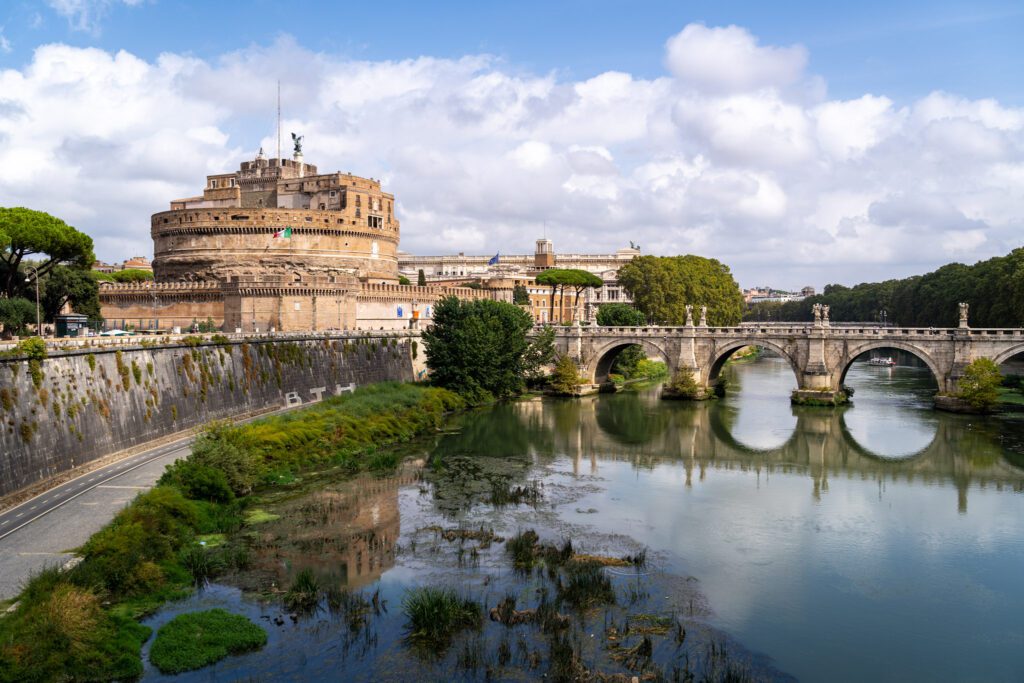
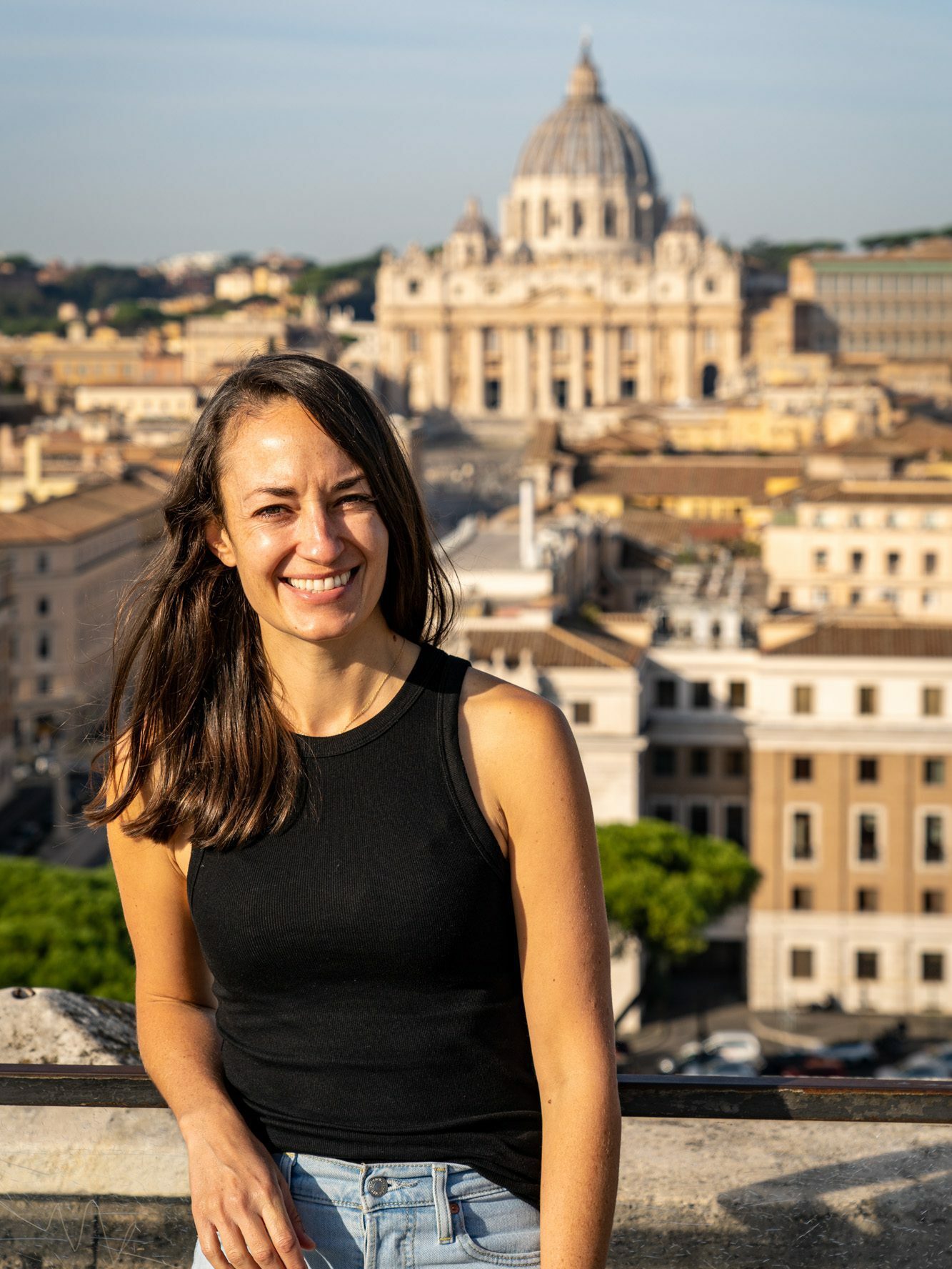
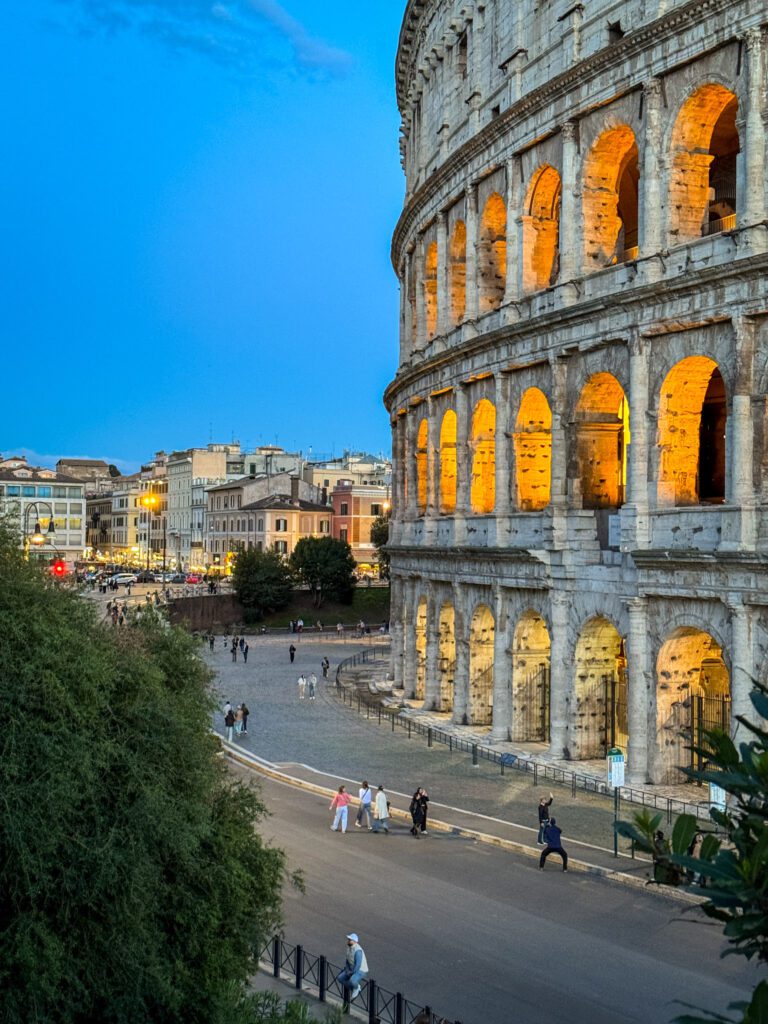
Disclaimer: Some of the links in this post, like hotel links, are affiliate links, meaning at no additional cost to you, we make a little bit of money if you click through and book. That being said, we would never recommend something to you that we don’t stand behind 100%.
26 Important Travel Tips for Your First Trip to Rome
We’re going to get straight into it, because we have a lot to cover here to make your first trip to Rome as smooth and enjoyable as possible.
We’re going to break this guide into three sections:
- Itinerary Planning and Logistics
- Navigating Italian Culture and Customs
- Exploring Rome’s Food (and Drink) Scene
For each section, we’ll cover several tips for visiting Rome that we think are important to know before your trip (and that we wish we’d known before our respective first trips more than a decade ago).
Off we go!
Itinerary Planning and Logistics
In this section, let’s talk about the things you should know around planning out your itinerary and the logistics involved, like how to get around, how many days to spend, and other things like that.
Plan to Spend a Minimum of 3 Days in Rome
Three full days is the absolute minimum we recommend in Rome.
A fourth day will make your trip even better and allow you to slow down and really experience the best of Rome – a leisurely al fresco lunch, an evening stroll, an unexpected stop for espresso at the bar – rather than running from attraction to attraction with no downtime in between.
We strongly recommend doing major attractions on separate days (more on this in a second).
Three days allows you to split up the Colosseum and Forum, the Vatican and St. Peter’s, and the Centro Storico to do them all on separate days.
They all are going to take at least four hours, and they’re best done as early as possible to avoid crowds and/or the heat.
Ideally – and we cover this more in our Rome itinerary, which you should read for help organizing your time – you actually split up the Vatican Museums and St. Peter’s Basilica so you can do them both first thing in the morning, which is where a fourth day is useful.
For the rest of those days, you can take the time to do a food tour, take a walk up behind Trastevere to Piazza Garibaldi (or wander through the Villa Borghese), and explore one of Rome’s less-visited neighborhoods (like Testaccio).
Book the Main Attractions ASAP
Sometimes we get emails to the effect of “you guys seem like big planners, I’m more of a just-show-up kind of traveler” and they’re asking about visiting a place like Rome and whether they really need to book things in advance.
Unfortunately, while that style of travel may be possible either a) a decade or two in the past or b) in a different city that isn’t one of the most visited in the world, that isn’t the current reality in Rome.
The current reality is that, if you want to visit some of the popular spots in Rome, you’re going to have to do some legwork to line them up in advance.
Particularly if you want to visit three sites: the Colosseum & Forum, the Vatican Museums, and the Borghese Gallery.
For all three of those attractions, you are essentially going to have to book them months in advance because they can and will sell out of tickets.
The exception is the dead of winter – December through February – when things are less busy. Even then, you’ll want to book a bit in advance.
In the summer, though, the tickets for the Colosseum and Vatican Museums sell out essentially instantaneously.
Here’s what you need to know about securing your tickets for those attractions.
The Colosseum & Roman Forum: We have an entire separate guide dedicated to visiting the Colosseum with for far more detail than we have here.
Tickets go on sale a month in advance at the time of the tour (basically to the minute), and by a week or two out your options will be severely limited, especially if you want one of the add-ons, like the underground areas.
Here is the official ticketing website.
There are many, many ticket options available, with all sorts of added extras. The basic ticket is the “24h – Colosseum, Roman Forum, Palatine” for €18, which includes admission to both the Colosseum and Roman Forum (which have separate entrances) over 24 hours.
The Vatican Museums: First of all, this includes the Sistine Chapel (it’s a part of the Vatican Museums), so you don’t need a separate ticket for that.
They go on sale 60 days in advance, and sell out within an hour if it’s peak season.
You should book your tickets as soon as possible so that you have access to the popular 8am and 8:30am entry slots.
Buy tickets for the Vatican Museums here – toggle the site to English with the language selector in the top right.
More information in our detailed guide to planning a visit to the Vatican.
The Borghese Gallery: While it’s less popular by volume than the previous two things we’ve covered, the Borghese Gallery is limited by the number of people they let in per day (only 360 per time slot at the time of writing). Book a month or so in advance. Book tickets on the official website here.
Now, that’s just to get tickets independently at cost. If you have the budget, you can usually find a way to see them at the last minute.
Tour operators tend to have tickets to bigger blocks of tickets, and you’ll likely be able to find a guided tour of the Colosseum (here’s the tour we’ve done and recommend) or Vatican Museums (here’s the early entry tour we’ve done and recommend).
The Crowds Are Intense (and There is No Low Season Anymore)
On my last two trips to Rome – in the spring of 2024 and 2025 – I have been absolutely flabbergasted at the crowds in Rome.
It’s particularly noticeable in three specific areas; the historic center, the Colosseum, and around the Vatican.
I noticed the congestion as I was walking past Piazza Venezia in Rome, but it wasn’t until I walked past the Pantheon that I realized just how many people were in Rome (and they all seemed to be at the Pantheon).
Over the course of those trips, I asked tour guides, baristas, and anyone else that would put up with broken Italian and switching over to English about the crowds, and every single one of them said that over the past two years it was the most tourists they’d ever seen (depending on their work, they all had slightly different takes on whether this was a good or bad thing).
Before those two trips, our previous trip to Rome was in the fall of 2021, when we spent a full 10 days exploring the city.
As you might imagine, the crowds at that point were very low (we were often the only Americans on tours, which meant that we got an awful lot of private tours that were supposed to be group tours).
It was a magical time to be in Europe – truly once in a lifetime for many reasons – and we will treasure those memories forever.
Those days are over, and the crowds are back. It is particularly evident at the major tourist attractions – the Colosseum and the Vatican – and in the historic center at places like Trevi Fountain and the Pantheon.
The question is what can you do about it.
We have three suggestions. But before we share them, the first and most important thing you can do is manage your expectations.
If you’re coming to Rome between April and October, you’re there during the high season, and there are going to be crowds.
The idealistic experience of marveling at the Sistine Chapel alone in quiet contemplation just does not exist at this point in time for most people.
Now, here are three things you can do to avoid crowds, to the extent that it is possible.
- Walk the historic center before 8am or after 10pm (ish)
- Pre-book main attractions to avoid missing out on experiences
- Book tours that offer off peak times (early morning or night tours)
Do Not Do Multiple Big Attractions on the Same Day
I’m writing this on the afternoon after I did a morning Vatican tour (the Pristine Sistine tour with Walks of Italy, my favorite tour company in Italy!), and my brain is absolutely fried to the point where I’m jotting down half coherent notes about the tour before I forget the details, and then I’m going to try to take a nap.
I cannot even imagine what it would be like to have done that tour either before or after visiting another similarly dense tourist attraction.
In Rome, I would absolutely make sure to split up the Colosseum and Vatican so that you’re doing them on separate days, leaving the rest of the day open for wandering a neighborhood, doing a food tour, or taking a nap to recharge.
Both the Colosseum and Vatican Museums + St. Peter’s Basilica are packed with history and culture, and a visit to either of them will sap your energy for different reasons.
The Vatican because there is SO MUCH to see, the Colosseum (and Forum) because you’re outside with no shade.
My number one piece of advice for you around how to schedule your time in Rome is to do major tourist attractions on separate days.
That will help you absorb the information rather than being a zombie for the second attraction of the day.
This is also a big reason why three days is the minimum we recommend for Rome.
It will give you plenty of time to split the big museums and historical sights up and do them on different days.
Try to Do the Vatican Museums and St. Peter’s Basilica on Separate Mornings
After my last trip to Rome with my mom and uncle, I would strongly recommend visiting the Vatican Museums and St. Peter’s Basilica on different days.
The reason is that, by the time you’re done with the Vatican Museums and Sistine Chapel, it will be around noon (maybe even later, depending on your pace).
Which means you’re going to be waiting in the security line that wraps around the piazza and you’re going to lose an hour or more of your precious time in Rome (plus, it’s HOT with no shade!).
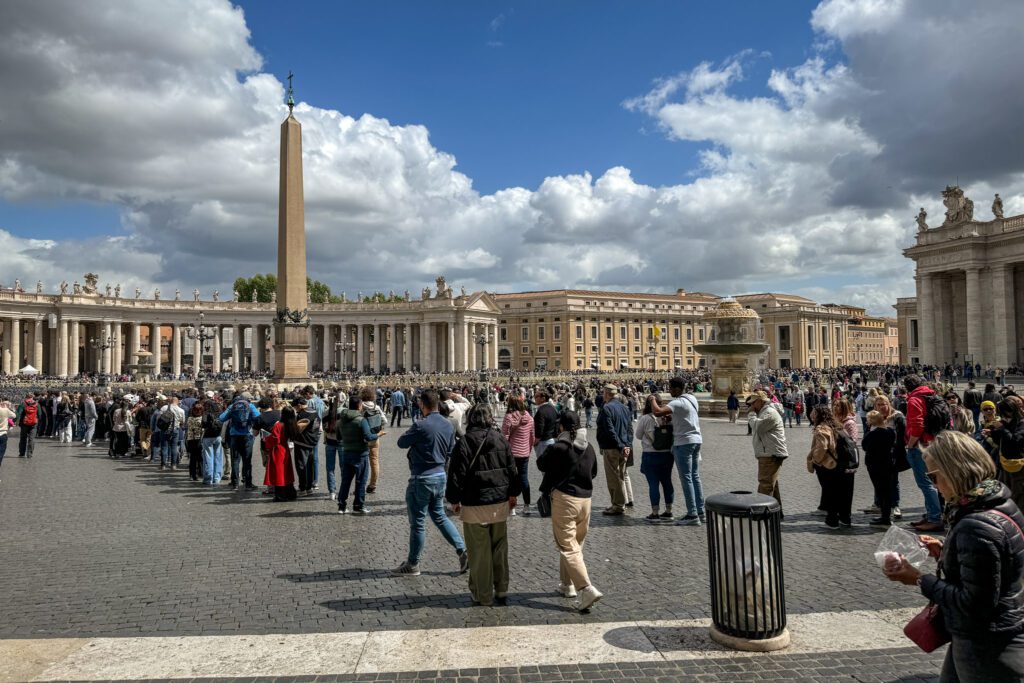
I would recommend, if you have the time, getting to St. Peter’s Basilica at opening (currently 7:00am) on a different day for a much more relaxing experience, and for the fact that the light will be better if you choose to climb the Dome (plus fewer people in the narrow passageways).
We arrived at about 6:45am on a weekday in March to visit St. Peter’s Basilica and there was already a somewhat hefty line formed at the gates, which was mostly made up of big groups.
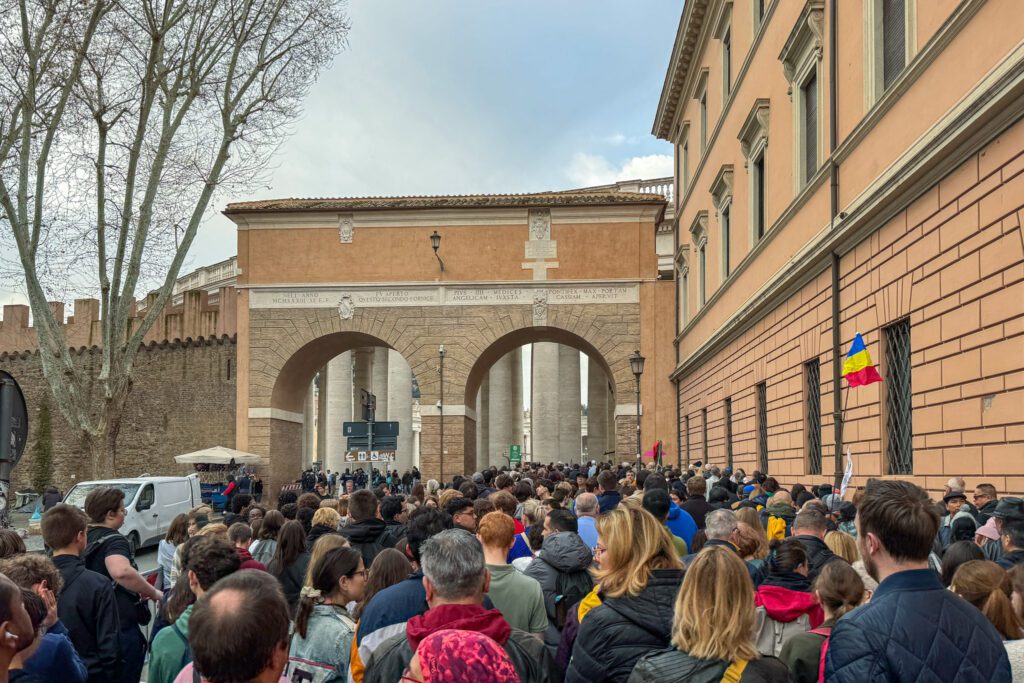
Still, it moved quickly and we were inside the basilica by 7:20am or so.
If you’re interested in climbing the dome, that part opens at 7:30am.
It is worth noting here that, if you do them on the same day, you will have to exit the Vatican Museums and wait in the (sometimes very long) security line for St. Peter’s Basilica because there is no cut through access (except for guided tours on certain days).
Visit the Centro Storico in the Early Morning and Late Evening
Rome’s historic center – the “Centro Storico” – is at its best in the early morning hours (pre-8am) and late evening (9pm and later).
On my two latest trips to Rome – which were in the spring during the past two years – I was surprised at just how many people there were in the historic center around 2pm on a weekday (low season doesn’t really exist in Rome these days).
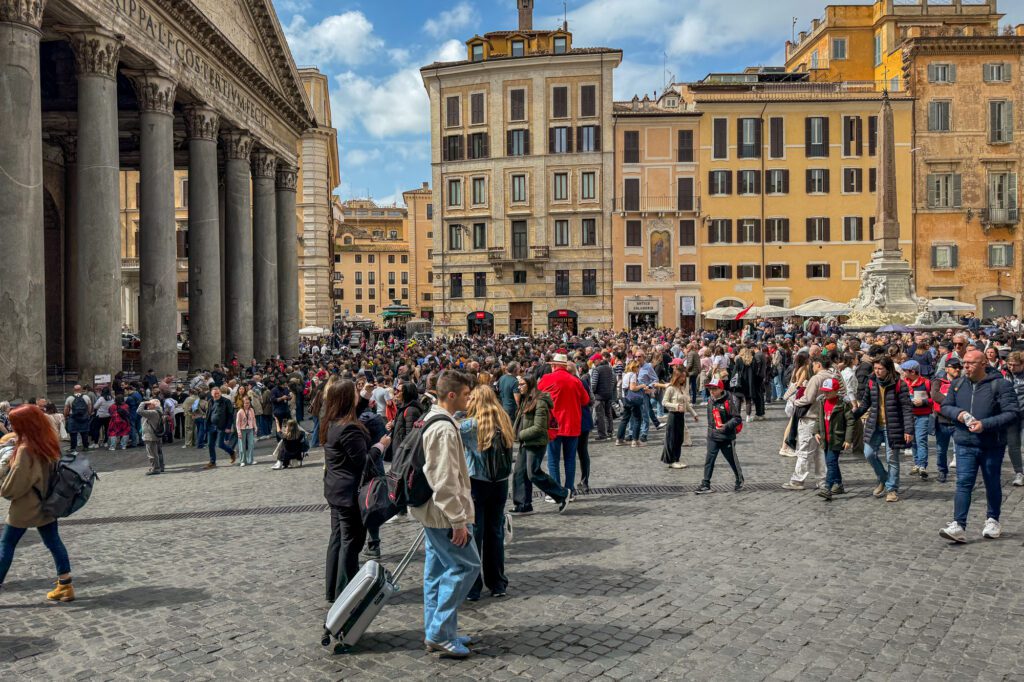
In fact, I brought my uncle, a first timer in Rome, to Trevi Fountain at peak time just so that the impact of seeing it at 7am hit that much harder.
The early morning and late evening offer different versions of the experience.
Both feature fewer people, but the early morning is when you’ll find the cobblestone streets nearly deserted, while the evening brings a buzzing energy with people (mostly tourists) dining and enjoying themselves.
Both are worthwhile, we think, and the early morning walk (which should look something like this) is a staple on just about any trip to Rome.
Get Out of the Historic Center
While Rome’s historic center is undoubtedly charming and fun to explore, it’s also the slice of Rome that hardly anyone who actually lives in Rome visits because of the massive crowds.
The result is sort of a mish mash that sort of shows the pros and cons of tourism in a nutshell.
On one hand, you have some of the historic monuments – the Pantheon, Trevi Fountain, etc etc – that make Rome a living museum (especially to people who live in the US or Canada, whose cities tend to be much younger).
On the other hand, you have a part of the city that is basically set up to cater exclusively to tourists, with restaurants with big cardboard menus with pictures and pushy salespeople and kiosks selling poorly made souvenirs all over the place.
If your only impression of Rome comes from that little slice of the city, it’s probably not going to be the best impression.
To get a feel for what really makes Rome special, it’s important that you spend part of your trip away from the chaotic center and venture out into neighborhoods where people actually live.
We’d say the ratio should be about 50/50 between historic center and other parts of Rome, but it depends on your style and how much time you have.
The three neighborhoods we like (and would recommend) are Trastevere, Prati, and Testaccio.
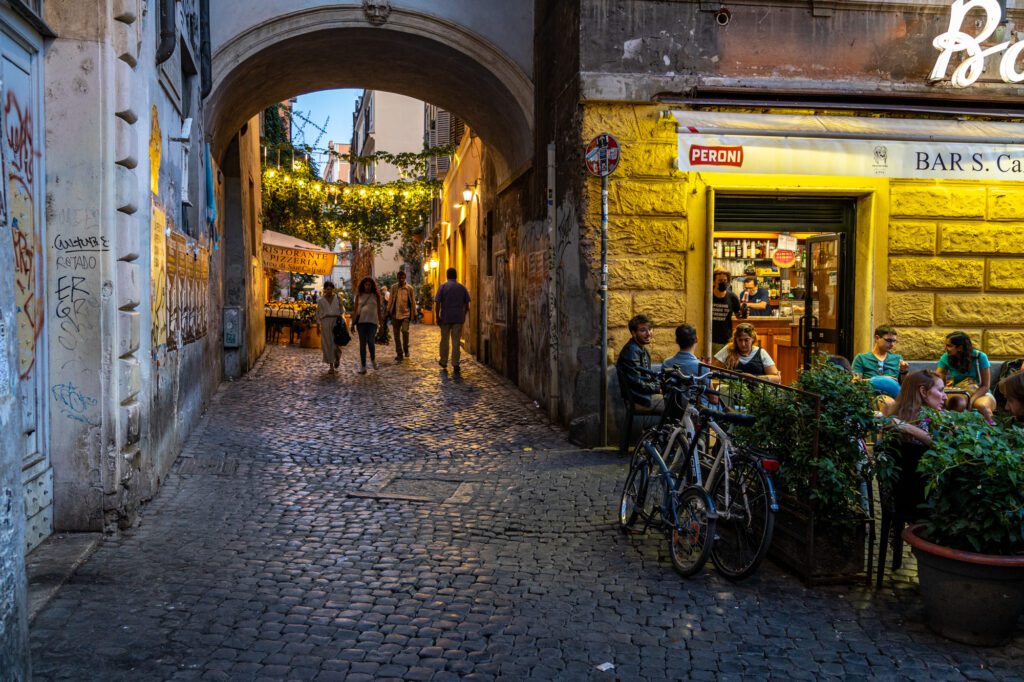

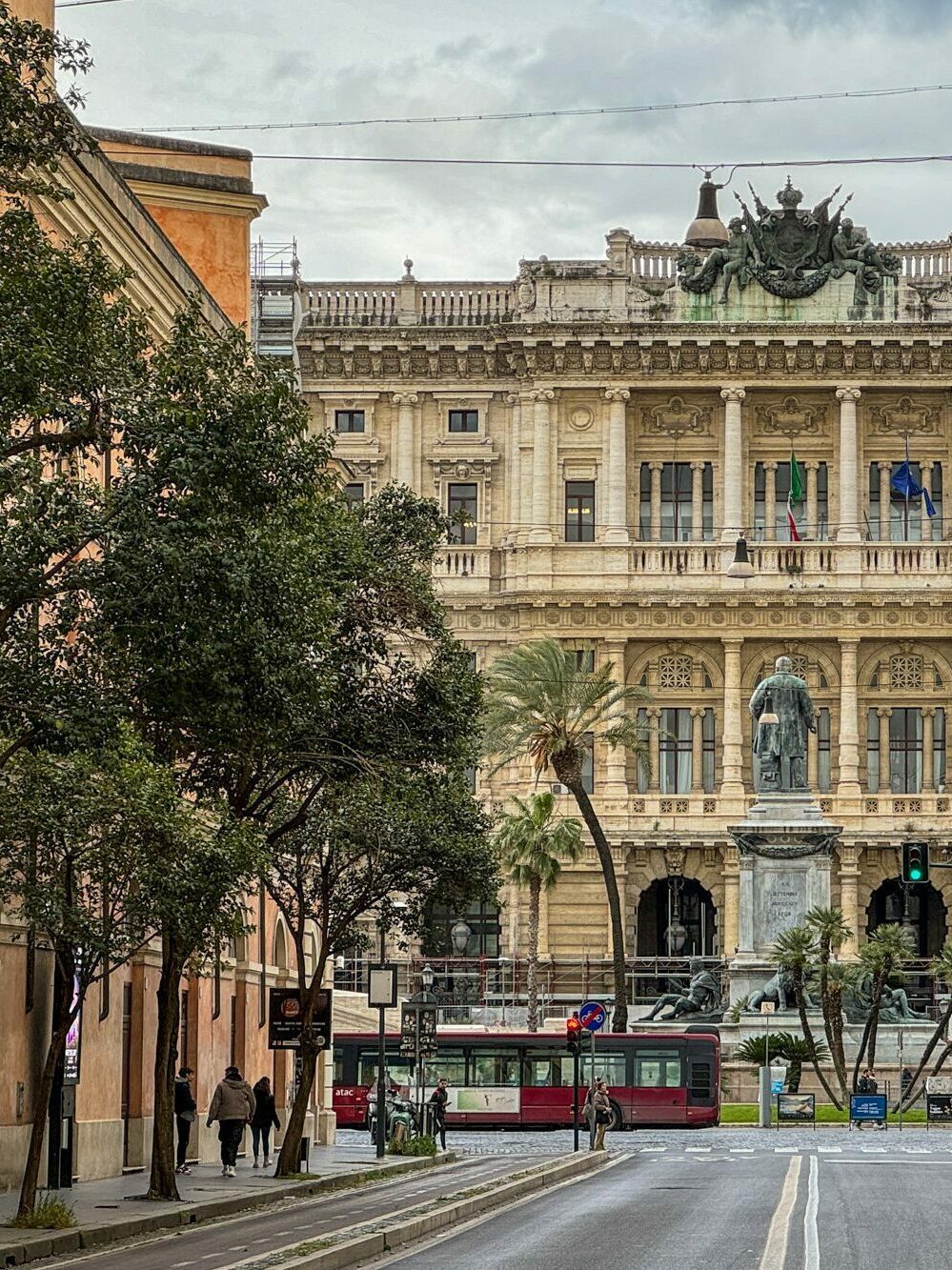
They all offer something a little different (Testaccio is working class, Prati is a little fancy), and they’re all adjacent to the historic center.
For more on what to do, see, eat, and drink in those places, head over to our guide to the best things to do in Rome for first timers, where we have an entire section dedicated to our favorite spots in those three neighborhoods.
Take the Leonardo Express To and From the Airport (Fiumicino)
Traffic in Rome can be horrible, and the lack of dedicated bus lanes means that most buses are subject to the same traffic as cars.
By taxi or bus, it’s going to take around an hour to get to and from the airport during the day (it’s shorter outside of peak times).
The best way to get to and from the airport is the Leonardo Express, a nonstop service run by Trenitalia between Rome’s Termini Station and Fiumicino Airport every 15-30 minutes for 14 Euros.
The journey takes just 32 minutes, and isn’t subject to the whims of road work and traffic jams.
The biggest challenge is that, depending on where you stay, you have to get to Termini Station to catch the train. Places like Trastevere aren’t particularly close to Termini.
Luckily, just about every bus and metro line runs to Termini, and you could always take a taxi if needed (just remember, traffic!).
If you’ve got a big group of people with lots of luggage, it might work out to be cheaper to take a taxi directly from the airport, which has a flat 50 Euro price for the center of Rome.
More information on the Leonardo Express here.
However, there is absolutely a scenario where the Leonardo Express doesn’t work: the early morning journey.
The Dreaded Early Morning Airport Journey
This is both the bane of my existence as a traveler and also one of the most common questions I get, both when I’m traveling and mention that I’m a travel writer and through emails from my newsletter subscribers planning their first European trip.
“How Do I Get to the Airport for my 7am Flight?”
Because many trans-Atlantic flights heading back to the US leave at around 10:30am AND there aren’t many options leaving from Rome, you’ll likely need to make a connection somewhere else in Europe (Paris, Amsterdam, and London are the common ones).
That means that, in order to have enough time to make that connection, you’re looking at a 7am (or earlier) flight out of Rome.
Which means arriving at the airport no later than 90 minutes before takeoff (I’d highly recommend longer if you’re checking bags, because it can be a hot mess).
Getting a ride to the airport at that hour is something you need to plan for in advance.
The public transportation options won’t be running (the Leonardo Express starts somewhere around 6:30am) and the taxi stands will probably be sparsely populated.
Your only choice, really, is having someone pick you up and drive you to the airport.
My suggestion, and what I always do, is to either ask your accommodations to help you pre-book a taxi to the airport at least 24 hours in advance OR to use an app like Uber or FreeNow to pre-book a rideshare to the airport.
Public Transportation in Rome Can Be VERY Hit or Miss
The biggest challenge with public transportation in Rome is the fact that the coverage of the underground metro system is fairly limited, which means that the buses are going to be your best bet in terms of getting around.
Unfortunately, the other thing that’s a little bit limited is dedicated bus lanes, which means that buses are subject to the same awful traffic that afflicts other modes of getting around (like taxis).
Combine that with the fact that buses are often packed to the brim near tourist attractions and Termini Station and you have yourself a very uncomfortable method of transportation.
However, I did still use public transportation fairly often during my two latest trips, and I used Google Maps with good success to find routes and timetables.
Generally speaking, don’t take buses in the Centro Storico during peak hours, because the buses are packed, and they’re stuck in bumper to bumper traffic constantly, so they move very slowly.
It’s not an exaggeration to say that it is often faster to walk a mile at 2pm on a Saturday than it is to hop on a bus.
They Do Check Tickets on Public Transportation
Multiple times over the course of my trip, a group of the Roman equivalent of transit police boarded a bus, fanned out, and began asking people for their validated ticket.
Without exception – it happened three or four times over the course of my last trip – the first or second person they asked had not paid for their trip (which is apparently a common occurrence for locals), and they had to get off at the next stop and, I imagine, pay a hefty fine.
The implication is this: don’t use the bus or tram without paying, otherwise you risk a fine. Especially when the fare is only about €1.50.
On the way to the airport on that latest trip, I hopped on the bus for a couple of stops to get to Termini to catch the Leonardo Express to the airport (more on that in a second).
I had my big backpack with me, and contemplated just riding without tapping my card (to avoid fighting to get to the front of the bus), but I put my head down and did it. Lucky for me, too, because a stop later the transit police boarded the bus and checked my ticket.
Here’s what you need to know about paying for the bus in Rome; gone are the days where you have to pre-buy tickets at a tabacchi before boarding – you can now tap your credit card at the machine near the front doors!
Which is great news for anyone who had experienced the disappointment that came with stopping in a tabacchi to grab a ticket and walk out to see the bus you needed pulling away from the stop.
You can also buy a tourist pass (e.g. 24, 48, 72 hours) that covers all forms of public transportation (buses, trams, and metro) in Rome. You still need to tap on and off on every bus/tram/metro trip.
Be Prepared to Carry Your Luggage
Make sure you’re prepared for this all-too-common scenario (I’ve had to do this, but not for a long time!): dragging your luggage along a rough cobblestone street at 4:30 in the morning.
But the bigger point here is that you should be prepared for the fact that the infrastructure in Rome might be a little less forgiving than what you have at home, and there will likely be at least one time on your trip where you will have to drag your luggage up a set of stairs at a train station or along a cobblestone street to your hotel.
A few years ago, my brother and I took my mom to Italy for her 60th birthday and she ended up bringing a HUGE suitcase.
I’ll give you one guess who ended up having to haul that thing up the stairs at train stations and up the hill in Cinque Terre.
I would strongly recommend packing into one bigger bag and one smaller backpack so that you don’t have too much to keep track of and carry, but obviously that depends on who you’re traveling with (e.g. kids mean more stuff) and your particular situation.
Rome Has Two Airports
As the title of this one suggests, Rome has two airports, and one of them is significantly more convenient than the other.
The most convenient airport – and the airport that the vast majority of visitors come into – is Leonardo da Vinci International Airport (colloquially known as Fiumicino, airport code FCO). It’s located west of Rome out near the coast, and it’s a relatively easy journey into the city center from there.
Chances are that unless you’re flying a low cost airline like EasyJet or RyanAir, you’ll be arriving at Fiumicino, which is good because it’s significantly easier to get to and from.
If you’re on a transatlantic flight from a major international carrier (or connecting from a transatlantic flight), you’re almost certainly going to arrive at Fiumicino.
Rome’s second airport is Giovan Battista Pastine International Airport (colloquially known as Ciampino, airport code CIA).
It’s not that it’s terribly inconvenient – it’s 16 miles south of the city – but the facilities and connections are undeniably worse (and there’s no direct train connection to the city center, which is a big pro of FCO).
In this section, let’s cover some of the cultural quirks about visiting Rome for the first time that would be better to know going in so that your expectations are set correctly.
Many of the negative things I hear about Rome revolve around the service being “worse” than it is “at home.”
Usually, this is coming from Americans, and it’s worth remembering that the incentive structures for servers or baristas in Italy and the US are set up completely differently. And it’s mainly driven by one factor (tipping) which we’ll get to below.
This is almost always a case of mismatched expectations, and we’re going to use this section to help set your expectations.
Service is certainly different in Rome – more passive, less cheery – but we’d reiterate something that we find ourselves saying often: “different” does not necessarily mean “worse.” In some ways, it’s nice to be left alone while you’re eating and enjoying some Italian wine.
However, it does mean that you should be aware of the slight differences and be prepared to navigate them, which is what this section is for!
We’re going to cover some of the cultural quirks that we’ve come across so that you’re aware of them and prepared to navigate them when they (inevitably) come up.
Note that we’re American, so we’re coming from that specific context and some of these differences may or may not be true with wherever home is for you.
Learn Some Basic Words and Phrases in Italian
I might be in the minority here, but I ALWAYS try to learn a few key words and phrases in the local language when I’m traveling.
Now, in a place that is a huge tourist destination like Rome, the majority of people in the hospitality industry speak English (not as well as, say, Amsterdam, but still fairly well compared to more rural parts of Italy).
But making an effort to speak the language almost always leads to a more friendly, warm experience in just about every imaginable situation, from greeting tour guides to ordering gelato.
Speaking of gelato, allow me to use an example that I encountered on my last night in Rome on my latest trip.
It’s important to note here that I do speak a very little bit of bad Italian (thanks to my Spanish and French), and I can order food or gelato entirely in Italian. However, the principle is clear here.
I was at my favorite gelato shop in Rome (more on this in a second) on my last night to end the trip on a high note. In front of me were two Brits deciding what flavors they wanted.
They never greeted the man behind the counter, and never made eye contact until they were ready to order. They then spoke in English, asking for a cup or cone and whatever flavors they wanted by pointing and asking for them in English.
The older Italian gentleman was surly and spoke very few words back to them, giving them their gelato and change with about as little emotion as is humanly possible.
I’m sure when he looked up to see me, an American-looking person, he was less than thrilled. But when I greeted him in Italian and asked him how he was doing, he lit up in a remarkable and unexpected transformation.
I even got a mini-Italian lesson on how to pronounce words with various combinations of c’s in Italian from another patron in the shop (who is an Italian teacher).
The point is this: a little bit of effort to learn a few key words and phrases in Italian is going to pay off 100x.
Here are the words and phrases I would learn (and their Italian counterparts with a little pronunciation guide).
- Hello – “buongiorno” (bone-jore-no) if it’s before 1-2pm, “buonasera” (bwone-ah-sarah) if it’s after 1-2pm
- Please – “per favore” (pair fah-vore-ay)
- Thank you – “grazie” (grah-zee-eh, though the last syllable changes depending on where in Italy you are)
- Goodbye – “ciao” (chow, but it’s better if you say it twice in a row!)
- Do you speak English? – “Parla Inglese?” (Par-lah Een-glay-zay)
- The bill/check please – “Il conto, per favore” (eel cone-tow pair fah-vore-ay)
- Where is XXX – “Dov’è XXX” (dough vay XXX)
- I would like XXX / We would like XXX – “Vorrei / Vorremmo” (Vore-ay / Vore-ay-moe)
An important note: The correct pronunciation of “thank you” in Italian, which is spelled “grazie”, is “grah-zee-ay.” Many people, my mom included, say something like “grah-zee” (the incorrect pronunciation rhymes with Yahtzee) and dump the last syllable, which is incorrect and will make you sound like you watched the Godfather one too many times before your trip.
You Need to Be Assertive with Servers (and Ask for the Check)
This is another difference that often befuddles Americans, and I’ve found that it really just comes down to mismatched expectations.
I vividly recall sitting at a gluten free restaurant on Campo de’ Fiori and watching several tables of Americans around me finish their food and look around expectantly, waiting for a server to stop by and ask if they were ready for the check.
Meanwhile, the servers were alternating between doing their job and standing around chatting amongst themselves while the diners got more and more visibly frustrated.
But the one thing they never did was make eye contact and ask for the check!
In fact, I actually told one of the tables who seemed to be getting more and more agitated to make eye contact with the server and make the universal “signing the check” symbol if they wanted to pay.
Miraculously, as soon as they did that, the server brought over the check and the card reader and they were off a few minutes later.
Here’s the thing. In the US, waiters are often ALL OVER you, asking if you’re ready to order, asking if you need anything else, refilling water, etc etc.
There’s a very good and very practical reason for this (aside from cultural differences): tipping.
We’ll cover tipping in a second (spoiler: it’s complicated), but the gist is this: servers in the US are often paid less than minimum wage as a base salary, and they make most of their money with tips.
Without making a judgment on how good this system is (okay I’ll bite, it’s terrible and just passes the burden of paying workers from businesses to customers), the outcome of that system is that servers are incentivized to be as friendly, jovial, and helpful as possible to maximize their tips.
Spoiler alert: that friendliness and jovial nature is often more a performance than anything else.
In Rome (and the rest of Europe, really), tips are a much smaller part of their income, so a lot of that veneer of friendliness and joviality is taken away, resulting in practical service that basically just leaves you alone unless you tell them you need something.
The takeaway is that, in order to get what you want or need at a restaurant in Rome, you’ll need to be a little more assertive than you’re used to at home. If you need something, including the check, you’ll need to flag down a server and ask for it.
Let’s Talk Tipping
Tipping is a complicated subject in Rome (and Europe more broadly).
Like I just mentioned, servers and baristas are paid a minimum wage that’s relatively higher than here in the US (there’s no lower minimum wage for tipped employees), so they’re not as reliant on tips as they are in the US.
However, tipping is still a nice thing to do for good service, especially in a restaurant setting.
There are countless guides out there that all say different things, so I asked a couple of Italians and expats who live in Italy what they do.
Generally speaking, they all said basically the same thing; tipping isn’t expected, but I still do it in certain scenarios (though one of them said they flat out don’t tip).
- For coffee at the bar, which is generally around 1.20 or 1.40, leave a tip of $.10 or $.20 per drink, preferably as coins on the bar as you leave
- For table service at a coffee shop or a bar, round up to the nearest Euro
- For table service at a restaurant, especially a nicer meal, add 5-10% to the total (or round up to the nearest round number, e.g. if the bill is 31.70, round up to 35.00).
The other thing to know about tipping is that at restaurants when you pay with a card, you have to tell them what the total amount you want to pay is BEFORE you actually pay.
Which is different from how we do it in the US where you would add the tip to the receipt AFTER you pay.
For example, say your total is 31.70 again. When you ask for the check and say you want to pay with a card, the server is going to put the total into the card reader and give it to you to tap/insert your card.
There’s no way to add the tip after you pay (unless you leave cash on the table), so you’ll have to tell them you want to leave a tip BEFORE you pay, and the best way to do it is to simply just say (in the example above) “35 Euros, please” before they put in the amount to the card reader.
If you’re paying with cash, the same general principle applies.
Tell them the total amount you’d like to pay, including any tip, when you hand them the cash.
For example, if your bill is 31.70, you want the total including tip to be 35, and you’re handing over 40 in cash, you’d say “5 Euros back, please” to indicate that you want to leave that extra as a tip.
Again, worth noting that there is no expectation around tipping like there is in the US, but you can still tip if you feel like you had a good experience and want to thank the server/restaurant.
Public Restrooms are Either Paid or Nonexistent
Another aspect of traveling in Rome, and Europe more broadly, is the idea of paying for a public restroom. Which is very much the norm as you’re traveling around Italy.
Even at places like the train station, you’ll usually need to pay a Euro to use the restroom.
This is not true at places you’ve paid to enter – like a museum or a restaurant – but the idea of free public restrooms in a place like a mall or a train station is not something you’ll find in Rome.
Be prepared to pay to use a restroom, either by buying a coffee or pastry (or a museum ticket), or with a couple of coins at public restrooms.
Sitting at a Table Usually Costs Extra
This is a big difference between cafe culture in the US and Rome that many people don’t realize until they experience it – coffee, food, and drinks are going to cost more if you get it “for here” and sit at a table than if you get it either to go or standing at the bar.
Which is why you’ll find so many Italians crowding the bar to get a coffee rather than sitting down at a table.
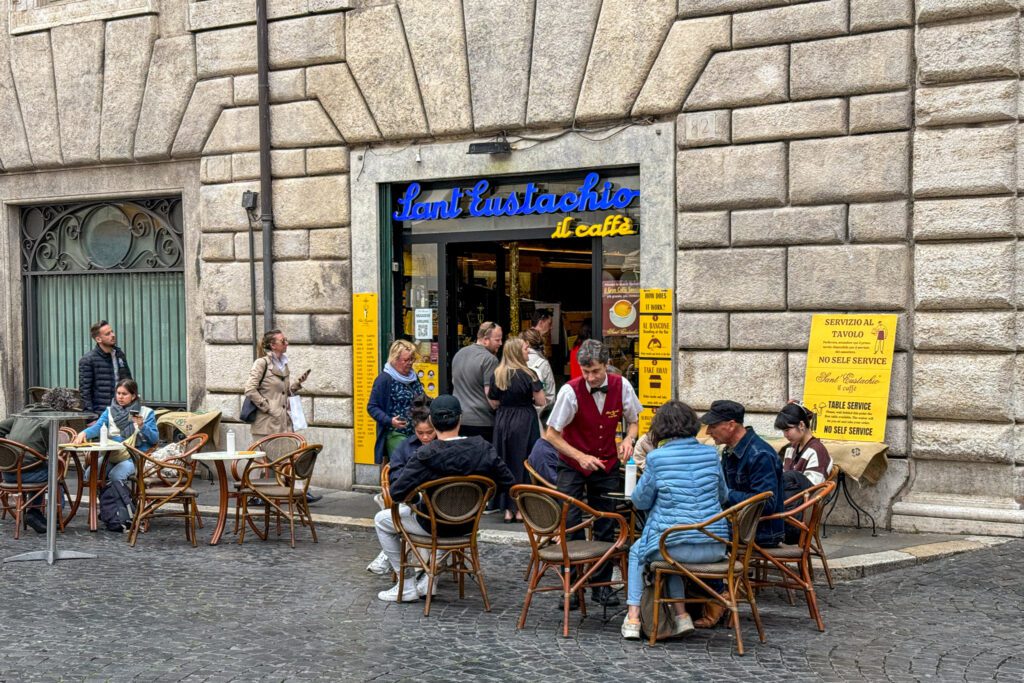
To me, this actually makes sense. It costs more in labor (you need a server) to offer table service, so it makes sense that it would cost more for the customer.
But I understand how that is somewhat unexpected if you’re coming from a US context.
If you’re looking to linger and stay awhile, just be aware that you’ll be paying a slightly (usually it’s only slightly) higher price.
Another thing to keep in mind is that, in some places (it varies by region and even by city) you’ll find “coperto” (in Rome, it’s usually called “servizio”) added to your bill, which is essentially a flat cover charge per person.
Technically, it’s not allowed in Rome, but restaurants tend to get around it by charging for bread or something like that.
It’s sort of a scam, but it’s a reality of dining out in Rome and arguing with servers about it (who don’t make the rules anyway) isn’t going to solve anything.
Exploring Rome’s Food (and Drink) Scene
I think one of the important things to remember before you visit Rome for the first time is that Italy as we know it (a unified country) is actually a relatively new concept in the scope of history.
Depending on which part of the process of unification you use, the unification of Italy happened sometime between 1861 (when the Kingdom of Italy was proclaimed with Florence as its capital) and 1871 (when Rome was brought into the fold and became the capital).
Before that – between the time of the Roman Empire and the 19th Century – the Italian peninsula was broken up into a series of independent city states and republics, some of which were controlled by bigger European powers like the Austrians or French (or even the Catholic Church – the Papal States were the last territory to stand against unification).
The fact that Italy is a relatively new concept means that each region is intensely regional, from linguistics (like accents and slang), to industries, to, of course, typical foods and drinks.
If there’s one thing you take away from this section on food in Rome, it’s that you should treat each region in Italy that you visit almost like you’re in a different country in the sense that what you eat and drink should change as you move around.
For example, what you should eat in Rome (the Roman pastas like carbonara and alla gricia, pizza al taglio, and carcioffi alla Romana) and what you should eat in Venice (seppie alla veneziana and pasta alla busara) are completely different.
Which makes sense, because the ingredients that you find in those two places are completely different based on their geography.
In this section, let’s talk about Roman food – what to look for, where to find it, and more.
Devour ALL of the ROMAN Food
Rome is an excellent food city, and we say that as two people who eat gluten free by necessity (sometimes Alysha gets to cheat, but Matt has Celiac Disease and will get deathly ill with just a crumb of gluten).
Italy happens to be a fantastic place to eat gluten free, so we largely got to eat and drink everything we wanted to while we were in Rome – gelato, simple pasta dishes (all with guanciale or pancetta), cannoli (which are Sicilian not Roman, but still very much worth eating), and things like fried artichokes and oxtail stew.
Let’s talk about what kinds of foods you should seek out when you’re in Rome.
Italian cuisine is diverse and multifaceted, and each region has a very, very different set of ingredients and, as a result, dishes that make it special.
For example, bolognese (which by the way is completely different from the Americanized version – here’s a recipe that we now make all the time and LOVE) is from Bologna and the surrounding area, while arancini (crispy fried rice balls) are a Sicilian specialty.
In Rome, the food is relatively simple.
And this is most evident in the pasta dishes you’ll find in Rome, which we’ve explored at home (through this excellent cookbook) and which usually are some combination of guanciale (or pancetta), cheese, and salt and pepper.
Here are the pasta dishes that are native to Rome and are worth ordering.
Cacio e pepe: As simple as it gets. Pasta, pecorino romano cheese, salt, and pepper. No butter – the creaminess comes from the starchy pasta water added back in at the end.
Carbonara: Again, incredibly simple. Eggs, cheese, and pancetta. Add in some salt and pepper, and you’ve got a delicious, hearty, filling pasta dish. This is my first memory of a meal in Rome, and we make it all the time at home now.
Pasta alla Gricia: Take cacio e pepe and add in some guanciale and white wine.
Pasta all’Amatriciana: Take pasta alla gricia and add in tomatoes and remove the white wine.
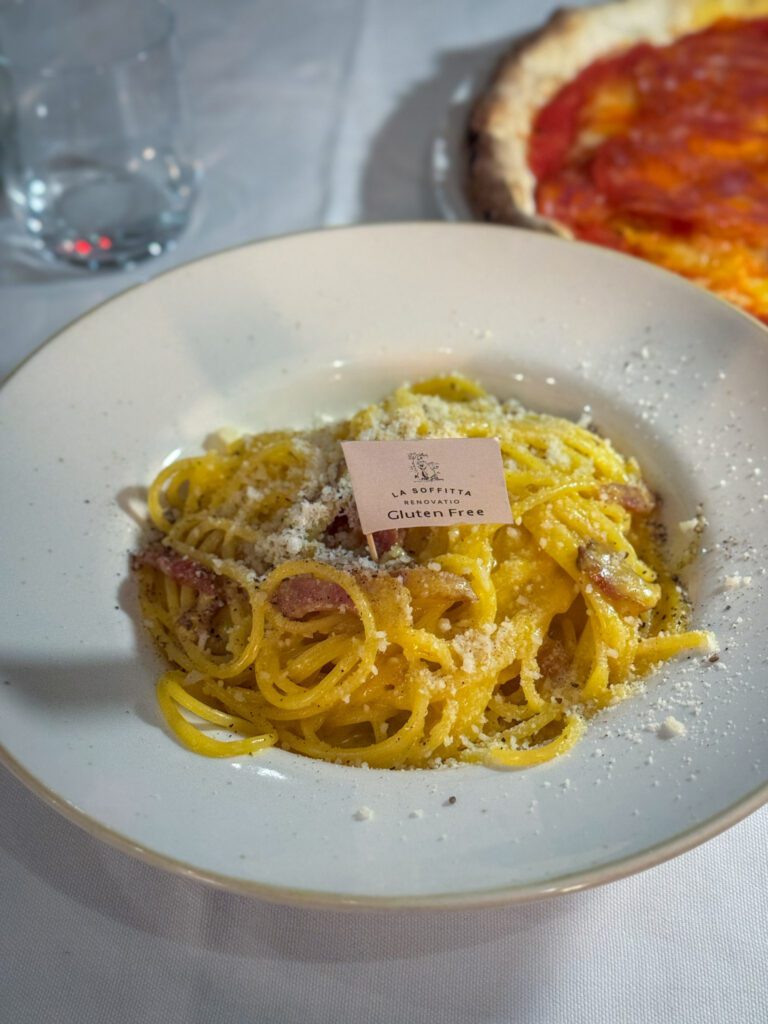
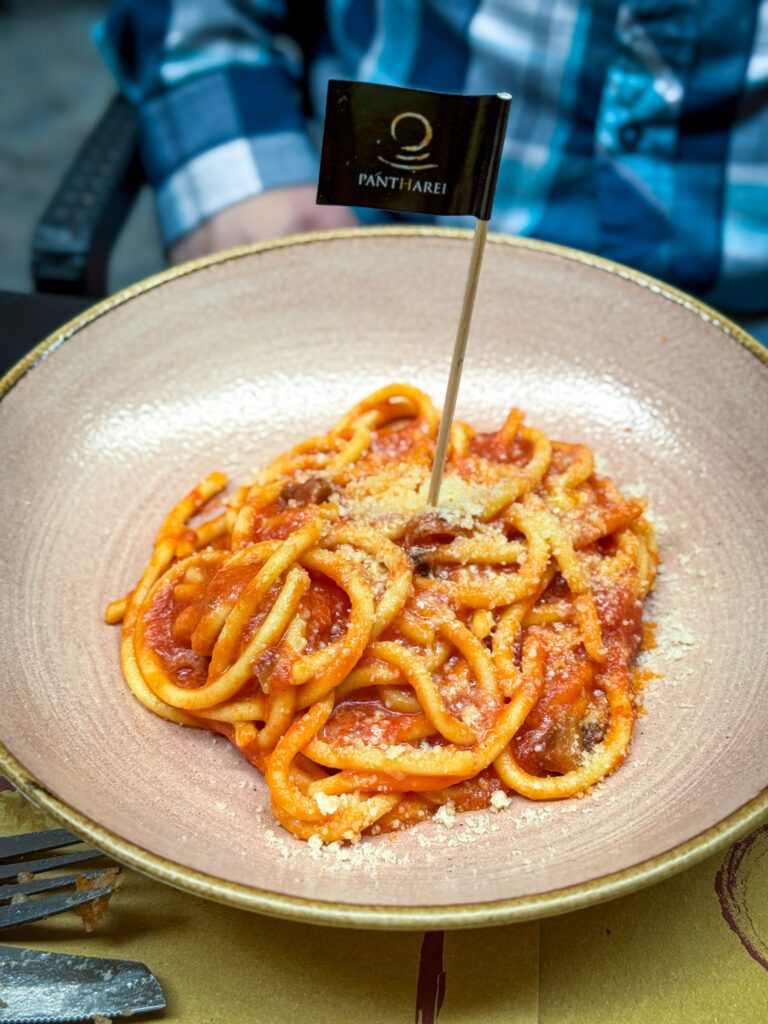
See? Super simple. And they’re all basically made with the same ingredients.
Outside of pasta, you should definitely try a few other things while you’re in Rome.
Pizza al taglio: Pizza by the slice (New Yorkers rejoice!) usually served cut into squares, not triangles. The most legendary version of this is a small shop near the Vatican, Pizzarium, though we noticed that Antico Forno Roscioli always had a line out the door (and my mom and uncle vote for Roscioli as a must-visit spot after we went there on our last trip!).
Anything with pecorino romano: We discovered this cheese at home as the best pasta cheese around, and it’s even better in Italy where you can get it closer to the source. It’s a hard, salty cheese, and it’s an ingredient in just about every pasta dish you’ll find in Rome.
Trippa alla Romana: Roman cuisine is pretty frugal which means you’re going to find cheaper cuts of meat around. We heard it’s because all of the good cuts of meat were taken by the nobility, which left the less desirable parts like tripe for the commoners, but we’re not sure how true that really is. This is a tomato-braised tripe with pancetta that is topped with, you guessed it, pecorino romano.
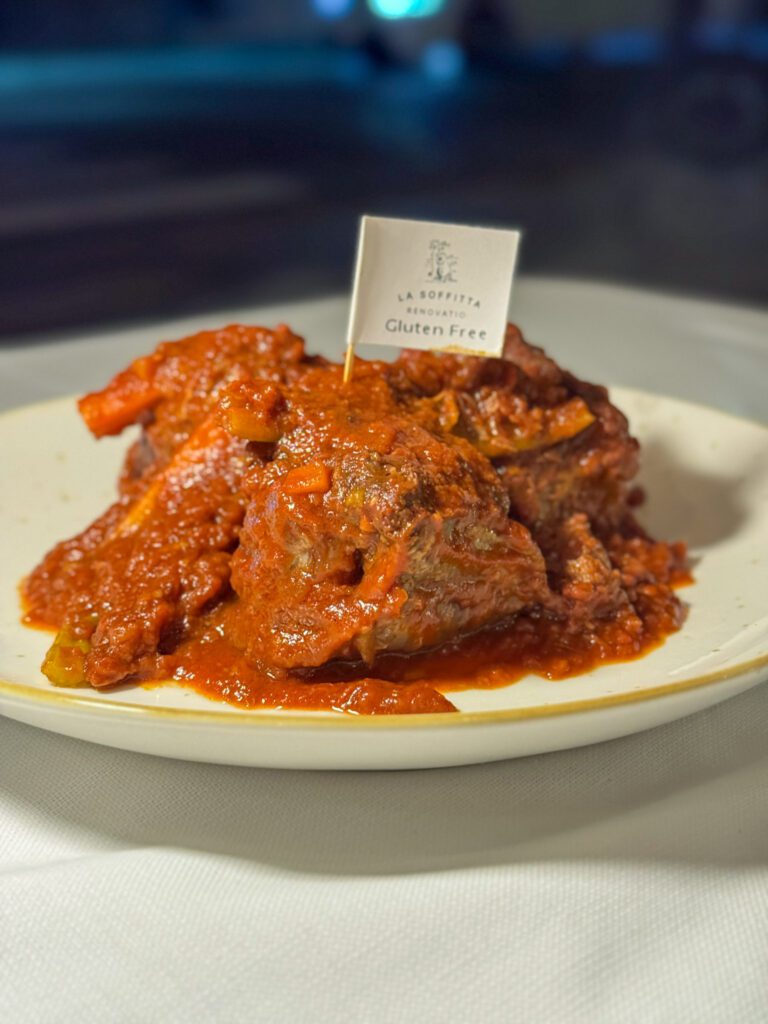
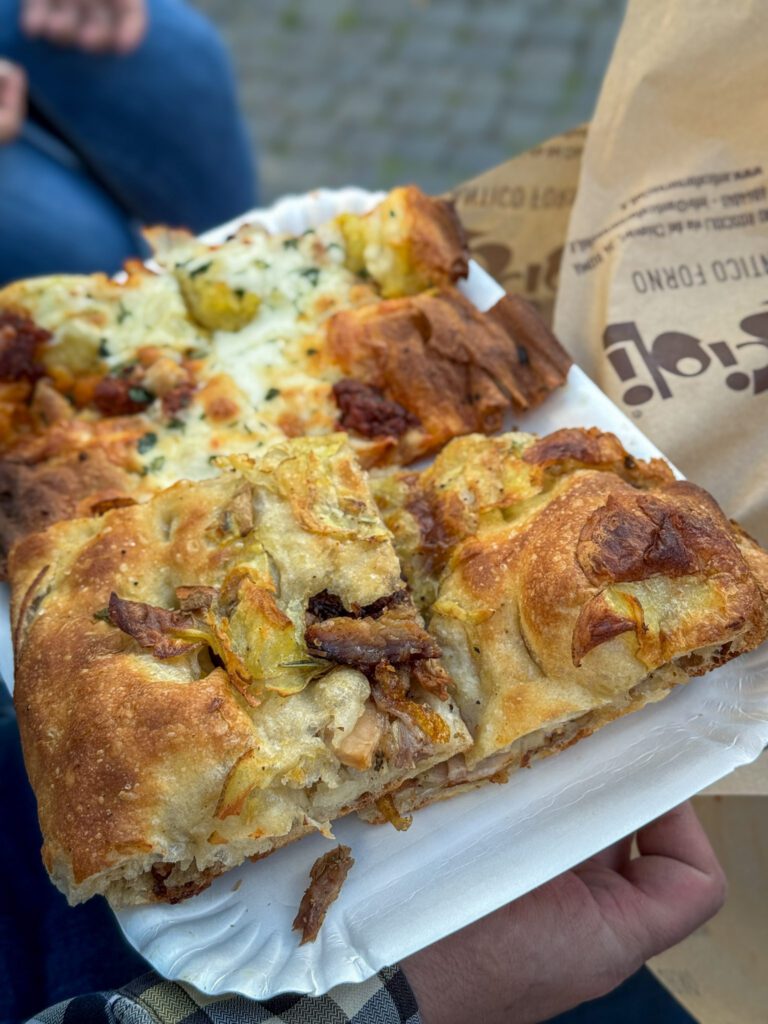
I have Celiac Disease and need to eat gluten free, which means my dietary restrictions make it hard to find the “best” version of these dishes (though I absolutely drag Alysha and/or my family to all sorts of places to seek them out).
However, there are two guides from Rome residents I’d recommend for the gluten-y versions: this guide from Mondo Mulia, and this guide from Luggage and Life.
I also really enjoy Katie Parla’s writing – she’s a food writer who lives in Rome and has a guide to Rome.
Italian Food and Italian-American Food Are Completely Separate Genres
One of the main criticisms I hear about the food in Italy more broadly, either by reading about people’s experiences or from people who email me, is that it’s not the same as the food they get at home.
Which is… absolutely true.
Italian-American food is almost a completely separate cuisine than regional Italian food.
For example, a few years ago I was deep into a “Roman pasta” phase where I was buying guanciale and pecorino romano by the pound and making a lot of carbonara.
During that phase, we went to Boston and went out to a restaurant in the North End (Boston’s Little Italy) known for authentic Italian food.
I saw carbonara on the menu and, of course, being deep into making carbonara myself, I ordered it.
To my horror, they used HEAVY CREAM in their carbonara AND they had the audacity to list it as an ingredient on the menu.
Which would absolutely make every Roman nonna roll over in their grave (along with cutting your spaghetti).
I knew from a lot of reading and listening to Roman food personalities talk about carbonara that the secret to a creamy carbonara is the mixture of warm pasta water, egg, and pecorino – NOT heavy cream.
But Italian-American food comes from a different context, so of course it’s going to look different.
The American palate is more used to rich foods and Italian-American food has risen to the occasion.
My point here is to remember that they’re different – don’t expect to find the classics from your favorite Italian restaurant at home in Italy – and if you find things like fettuccine alfredo or chicken parmigiana on a menu in Italy, you should probably eat elsewhere.
Avoid Places with Pictures on the Menu OR a Salesperson Outside
This is a good rule to live by in any city, and is a very common occurrence in the historic center of Rome.
You’ll be walking down a street lined with restaurants, and there will be a big cardboard menu outside covered in pictures with a couple of servers whose job is to lure you in for a meal.
Don’t do it. That’s the tip here.
Again, rather than walking around in a place full of tourists and choosing a place based on vibes, seek out experts who can help you find somewhere to eat that is going to give you a real taste of the food that you’re looking to experience.
You’re Going to Pay for Water at Restaurants
This is another little quirk that you should know before you go to Rome (or any city in Italy, or France, or Spain…etc etc); free tap water at a restaurant is not something that is generally available.
In fact, many places simply will not give it to you even if you ask for it.
Instead, if you want water with your meal, you’ll need to buy a bottle of water. Just accept it as a fact and go with it.
You can choose between still (acqua minerale) and sparkling (acqua frizzante), and they both usually cost about the same (a couple of Euros for a bigger bottle).
We’d also add to this that you’re very unlikely to find ice to put in your water.
It’s just not a thing that people in Rome (or most other places in Europe) do, and they don’t have the infrastructure (ice machines, mostly) to offer it to you.
Drink the Local Wine
Similar to food, wine is also intensely regionalized in Rome which, again, makes total sense when you think about the context of Italy as a series of independent republics and city states over the past 1,000 years or so.
For a combination of many reasons, Italian wine just hits differently than wine from the new world.
My somewhat educated opinion is that it’s roughly equal parts centuries of farming and winemaking expertise and the fact that you’re on vacation, so everything just tastes a little bit better.
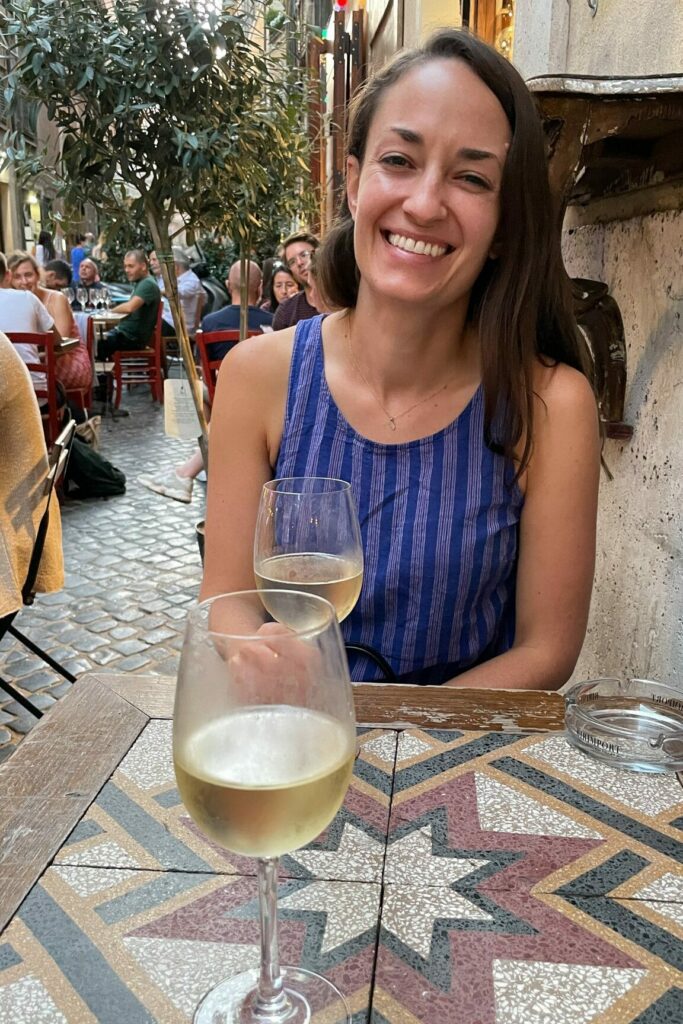
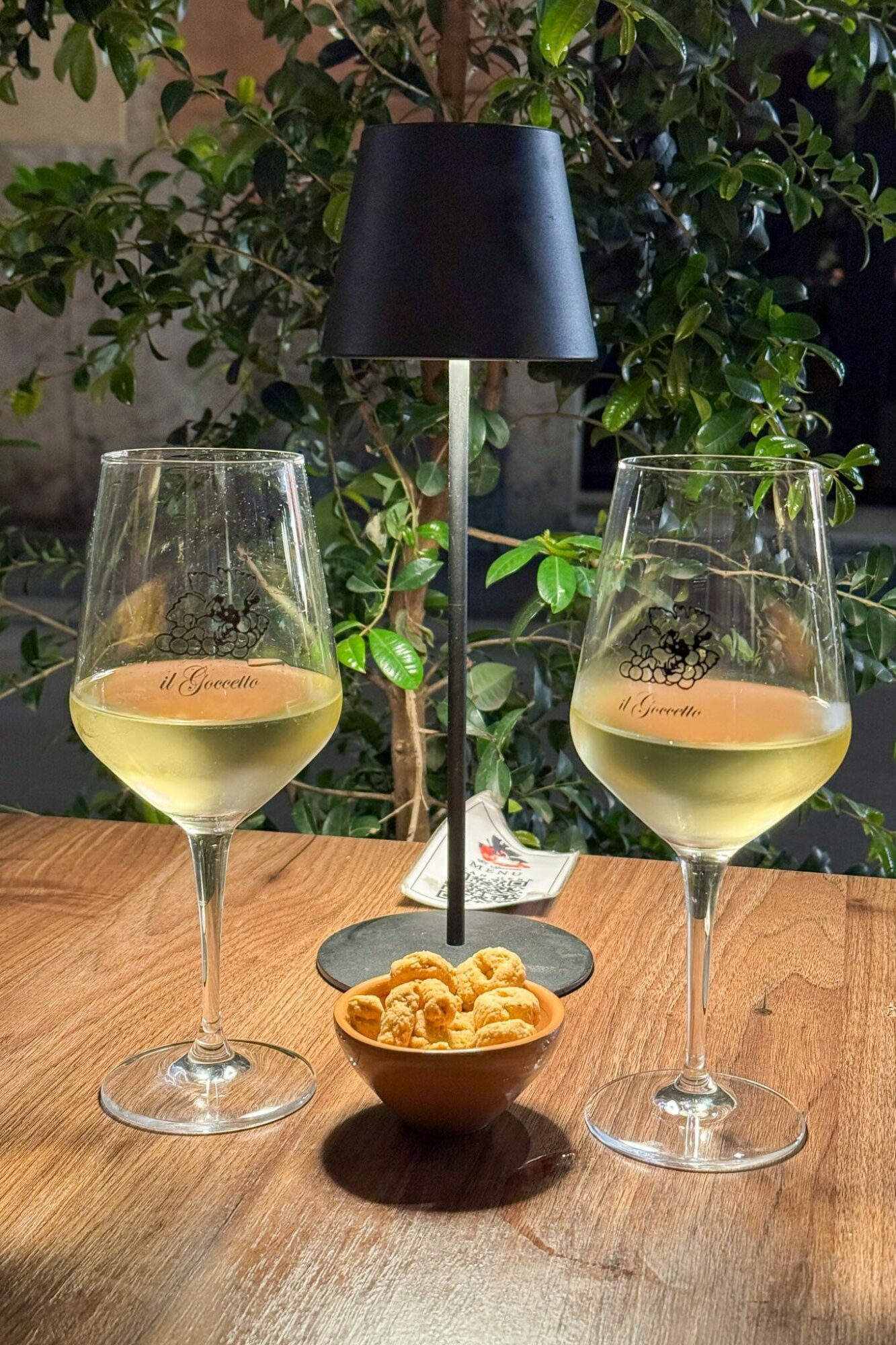
There are somewhere around 320-350 different wine varieties in Italy, and as you move from region to region, the wines you’re likely to encounter are going to change.
In most places, especially ones that see a lot of tourists, you’re likely to encounter wines like pinot grigio and prosecco whether or not you’re in the place where those wines are made.
While those wines are great, I’d make it a priority to try a wine or two from Lazio that you’re unfamiliar with (and the best way to find them is to ask servers for help, particularly at wine bars).
Another tip here: The house wine in Italy (“vino della casa”) is almost always somewhere between “fine” and “really good” ESPECIALLY when you consider the price (a few Euros a glass). We’re always surprised at how good the house wine is when we’re in Italy, and we wouldn’t shy away from ordering it (in fact, we’d encourage it).
Bring a Reusable Water Bottle to Refill
This is true for just about every destination around the world, but you should absolutely bring a reusable water bottle to refill rather than buying a bunch of plastic water bottles over the course of your trip.
Tap water in Italy is safe to drink, and Rome actually has a bunch of cool old water fountains around the city that are safe to drink from (and refill your bottle) that even offer sparkling water. For free!
There’s one near the Colosseum (on the southwest side of the square near the Arch of Constantine) that we went to multiple times.
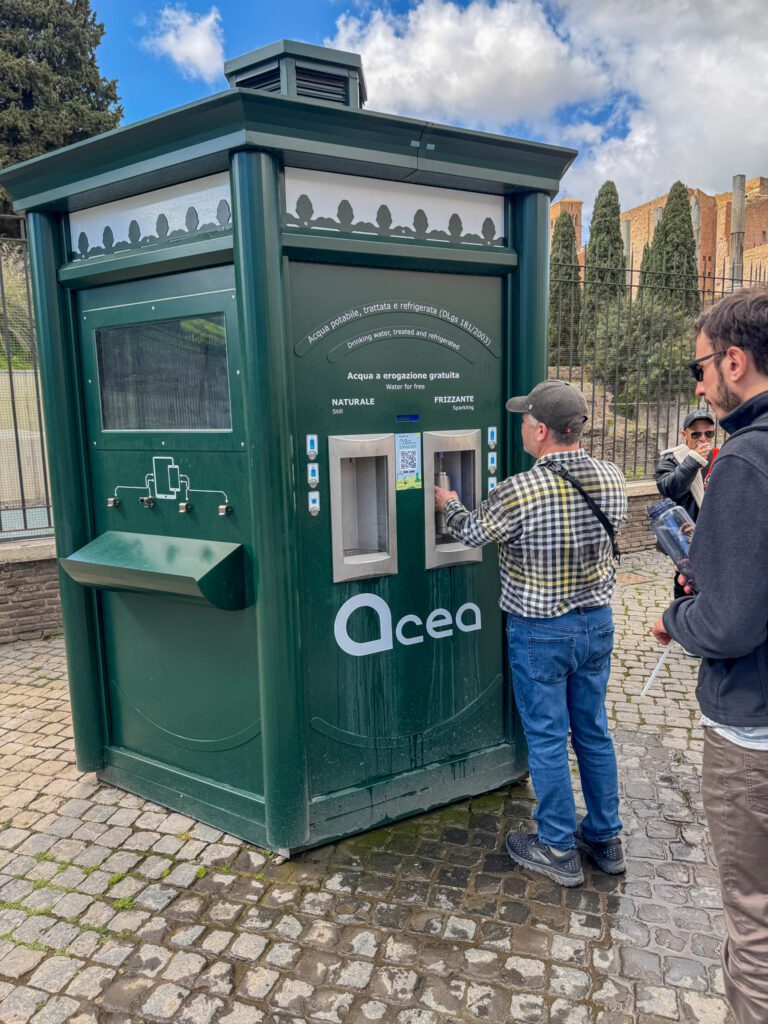
Embrace the “Caffe e Cornetto” of it All
As a general rule, Italians don’t buy the whole “breakfast is the most important meal of the day” nonsense that has been drilled into Americans since we were toddlers (thanks, multinational cereal conglomerates).
In fact, the only places I’ve really seen breakfast are at either hotels (that cater to tourists), restaurants near tourist attractions like the Colosseum and Vatican (that cater to tourists), and hipster brunch restaurants (that cater to tourists).
Instead, many Romans start their day with a coffee, a pastry (the cornetto, which is similar to a croissant BUT NOT THE SAME, is a common choice), and sometimes a cigarette. And they usually do it standing at the bar.
When in Rome, right? We’re not huge breakfast people anyway, so we fully embrace the caffe e cornetto lifestyle when we’re in Rome (though, Matt can’t really do the cornetto in most places, so it’s just caffe part, I guess).
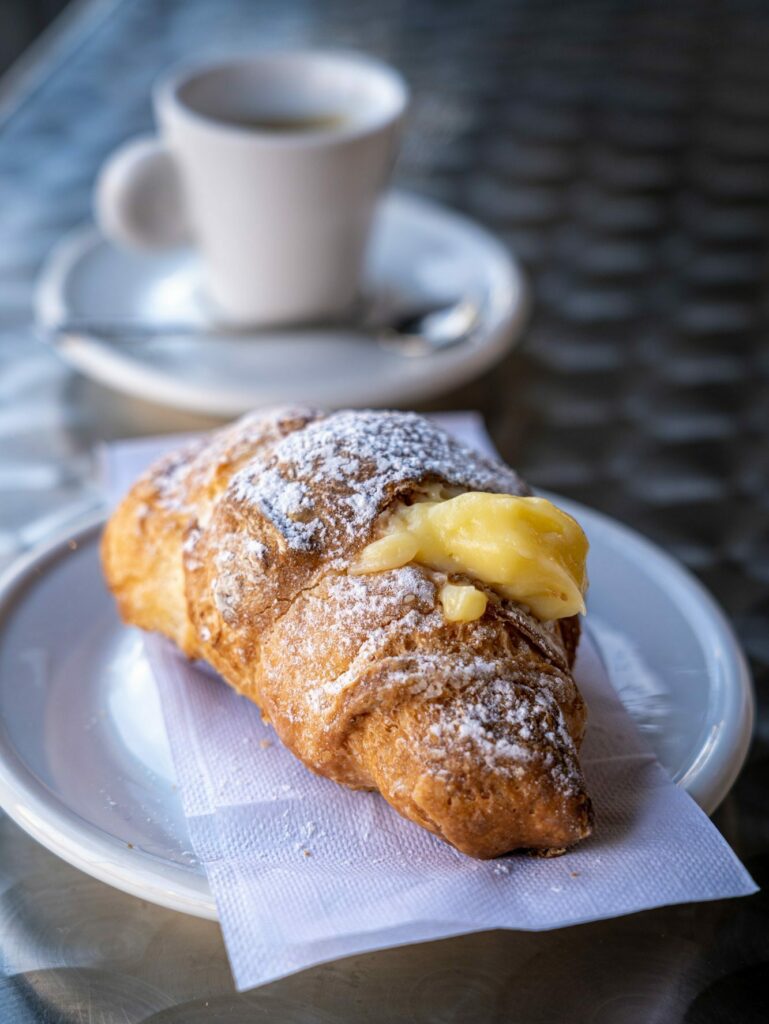
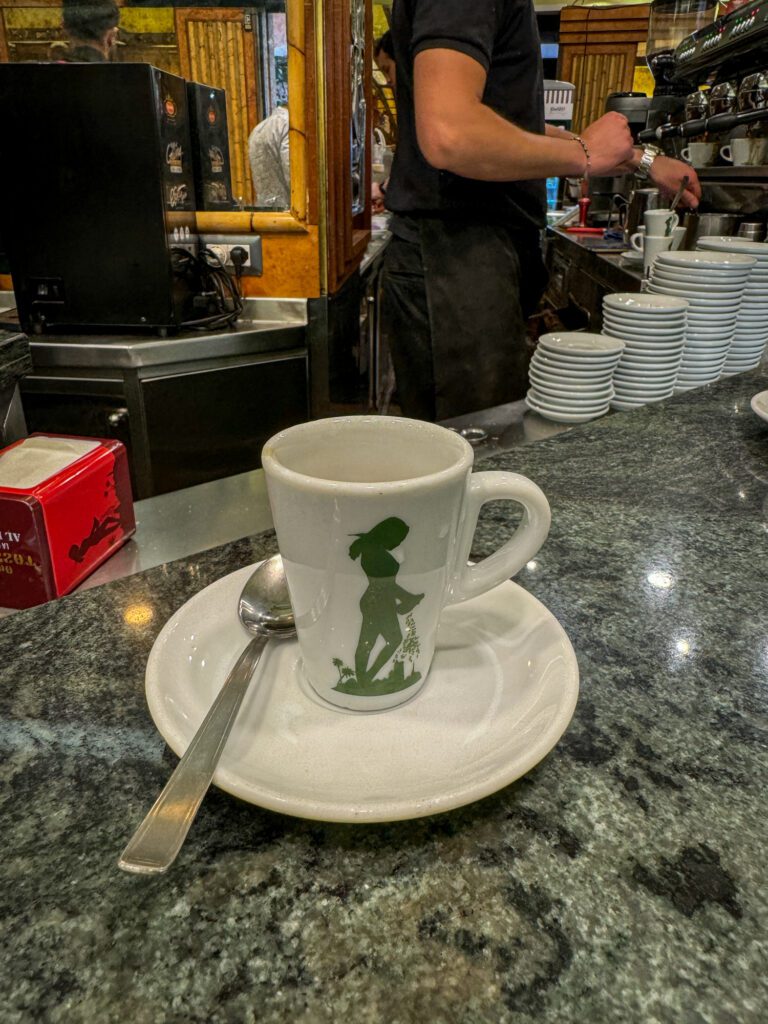
Don’t Eat Within a Few Blocks of the Major Attractions
This is a good general rule to follow almost anywhere in the world, but it’s particularly relevant in Rome where you have some of the most visited tourist attractions in the world like the Colosseum and Vatican.
Generally speaking, the quality of food that you find near those major tourist attractions is going to be worse, AND the price is going to be higher (sometimes you even get an added cover charge for the location).
Plus, the menus in those places are going to skew towards catering to the palate of visitors rather than locals, which means you’re missing out on the local specialties that make each region unique (we sort of covered this above).
Those restaurants are seeing a steady stream of people day in and day out, and there’s no real incentive for them to serve great food because they don’t really need to.
If we were you, we’d avoid eating within a few blocks of any of the major tourist attractions in Rome (with a few exceptions).
With all that said, we would also say that there is something special about enjoying a coffee or spritz with a view of the Colosseum, so if that’s something you’re into, just go into it knowing that you’re going to pay a premium for a product that is probably not as good as you might find elsewhere.
Planning a trip to Italy? We’d love to help!
Here are our other Italy travel guides to help you plan an incredible trip (even if you have to eat gluten free!).
If there’s no link below, it means we’re still working on it – long, in-depth guides take time! We’re working on it, though, we promise.
If you’re planning a trip and you’re not sure where to start, your first stop should probably be one of our detailed itineraries.
We have a two week Italy itinerary that blends the main cities with some less-visited cities that we love (BOLOGNA!), a guide to spending 10 days in Italy that focuses mostly on the highlights, and a whirlwind guide to spending one week in Italy that features the Rome – Florence – Venice highlight circuit.
We also have a guide covering important tips for traveling to Italy for the first time, which is a collection of things we’ve learned over the course of our time in Italy that will help you have a smoother, more immersive trip.
Here are more specific guides to the main cities in Italy.
Rome
- What to do in Rome (as a First Timer)
- How to Plan an Amazing 4 Day Rome Itinerary
- Where to Stay in Rome: A Complete Guide for First Timers
- 26 Things to Know Before You Visit Rome
- Gluten Free Rome: A Complete Guide to GF Restaurants + Bakeries
- Where to Find the Best Specialty Coffee in Rome
Florence
- What to do in Florence (as a First Timer)
- How to Plan an Amazing Florence Itinerary (3 Days)
- Where to Stay in Florence: A Complete Guide for First Timers
- Gluten Free Florence: A Complete Guide to GF Restaurants + Bakeries
- Where to Find the Best Specialty Coffee in Florence (for Coffee Nerds)
- The Best Day Trips from Florence (Complete Planning Guide)
Venice
- A Perfect 3 Day Venice Itinerary (for First Timers)
- Exactly What to Do in Venice (As a First Timer)
- Where to Stay in Venice: A Complete Guide
- Gluten Free Venice: A Complete Guide (for Foodies)
Bologna
- What to do in Bologna (as a First Timer)
- How to Spend One Incredible Day in Bologna
- How to Plan an Amazing Bologna Itinerary (2 Days)
- Where to Stay in Bologna: A Complete Guide for First Timers
Cinque Terre
- What to do in Cinque Terre (as a First Timer)
- How to Plan an Amazing Cinque Terre Itinerary (2 Days)
- Where to Stay in Cinque Terre: A Complete Guide for First Timers
Milan
- What to do in Milan (as a First Timer)
- How to Plan an Amazing Milan Itinerary (2 Days)
- Where to Stay in Milan: A Complete Guide for First Timers
- Gluten Free Milan: A Complete Guide to GF Restaurants + Bakeries
The Rest of Italy
